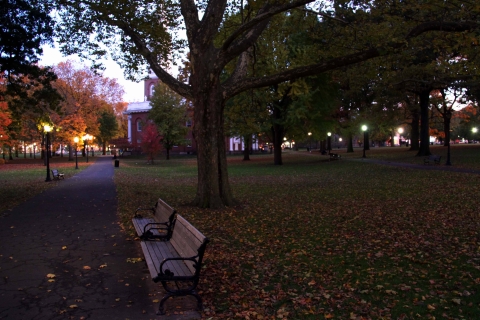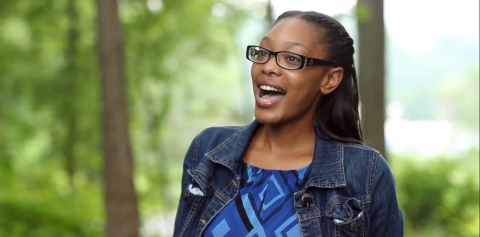New Haven, Connecticut
New Haven lies along the northern shore of Long Island Sound, nearly equidistant from New York and Boston. With a small-town feel and historic neighborhoods, New Haven also has the amenities of a larger city, including art museums, theaters, and restaurants. It is also home to Handsome Dan of Yale University.
New Haven has a long tradition of innovations from creating the first telephone exchange to its own style of pizza. Founded in 1638 — as a colony, the city was laid out in squares that surround a public space known as the New Haven Green. The elm trees surrounding the Green were planted as part of the first public tree-planting program in 1686 and gave the city its nickname, Elm City.
Today, New Haven is a stellar model of community-led, urban habitat conservation. Organizations like the New Haven Land Trust are working with the U.S. Fish & Wildlife Service (Service) to conserve natural places for people and native wildlife.
New Haven Land Trust
With 80% of Americans living in cities just like New Haven, it is important for communities to maintain a connection with nature. Engaging with nature is good for us; studies have indicated that nature has a positive effect on people’s health and happiness. Nature can also provide other benefits for local communities — to find out more check out Investing in Nature story.
The New Haven Land Trust — Connecticut’s first urban land trust — worked to preserve open land in New Haven and give city residents opportunities to access and learn about the environment. In 2020, after years of collaboration, the Land Trust merged with New Haven Farms to form Gather New Haven: Neighbors and Nature Thriving Together.
Gather New Haven’s mission is to promote health, equity, and justice for people and the environment by cultivating connections with each other and our local lands and waters, and by inspiring us to care for ourselves, our community, and the natural world.
Gather New Haven continues to manage the six urban, nature preserves acquired by the New Haven Land Trust, including Long Wharf Nature Preserve. The organization also manages nearly 50 community gardens throughout the city.
Long Wharf Nature Preserve
Established by the New Haven Land Trust in 1994, the land and water that is nowLong Wharf Nature Preserve hasn’t always been the beautiful natural space it is today. Located right next to Interstate 95, you can now take a tour of natural habitats — walking trails that wind through tidal wetlands, salt marsh salt marsh
Salt marshes are found in tidal areas near the coast, where freshwater mixes with saltwater.
Learn more about salt marsh , sand dunes and grassland all just a few steps from the highway. The Preserve is also home to Schooner, Inc.‘s coastal exploration initiatives and summer camp.
The Land Trust, Audubon Connecticut, Coastal Program, and others worked together as part of the New Haven Harbor Watershed Urban Wildlife Refuge Partnership to restore migratory bird habitat in this community’s backyard — and today, over 100 species of coastal birds can call Long Wharf Nature Preserve home.
Watch a video about the Long Wharf Community
Solar Youth
There is a tremendous need for positive youth development in New Haven’s underserved neighborhoods. Rising to this challenge is Solar Youth — an organization that empowers youth to achieve lifelong success in part by instilling a sense of community stewardship among New Haven’s next generation.
“A lot of the members of the community don’t see how they are connected to nature or how important it is for the ecosystems in these areas to thrive.” — Jaleesa Freeman, Development Officer for Solar Youth
Solar Youth carry out programs for local kids in their own neighborhoods — promoting exploration of nature and inspiring leadership. Organizations like Solar Youth need access to natural places like Long Wharf Nature Preserve to provide youth with a place where they can experience nature first hand — instilling in them a sense of wanting to protect their city’s oasis.
Urban habitat conservation is critical to the Service’s mission — to work with others to conserve, protect, and enhance fish, wildlife, plants, and their habitats for the continuing benefit of the American people. Leading the Service’s efforts to engage urban communities and to conserve nearby natural places are the Urban Wildlife Conservation Program and the Coastal Program.
The Urban Wildlife Conservation Program (Urban Program) empowers local organizations, cities, and towns across the country to seek innovative community-based solutions for wildlife conservation. Working to understand the conservation issues as they affect local communities, the Urban Program directs Service resources to address these needs to help fish, wildlife and people.
“Our partners give us the opportunity to really connect with local communities, while reaching our conservation objectives as the U.S Fish and Wildlife Service.” — Cindy Corsair, Coastal Program Biologist
The Coastal Program provides technical and financial assistance to local communities and partners to restore and protect habitats that benefit fish, wildlife, and people. We also develop resources that help land managers and practitioners to better deliver conservation. By working together, we can sustain the people and wildlife that rely on coastal and marine ecosystems.
Epicenter for Local Engagement
The protection and restoration of Long Wharf Nature Preserve created an epicenter for community engagement — connecting people with nature and inspiring future generations of environmental stewards. The continued efforts of organizations like the New Haven Land Trust and Solar Youth and partners like the U.S. Fish and Wildlife Service ensure a beautiful future for everyone, no matter where they live.
The U.S. Fish and Wildlife Service’s Coastal Program is a voluntary conservation initiative that works with communities to restore and protect land and water resources important to them. The Coastal Program provides technical and financial assistance for habitat conservation on public and private lands along the coast, including the Great Lakes, Alaska, Hawaii, and Puerto Rico. Learn more at Coastal Program.
By Amanda Lawrence, 2020 Knauss Fellow and Chris Eng, Coastal Program Biologist








